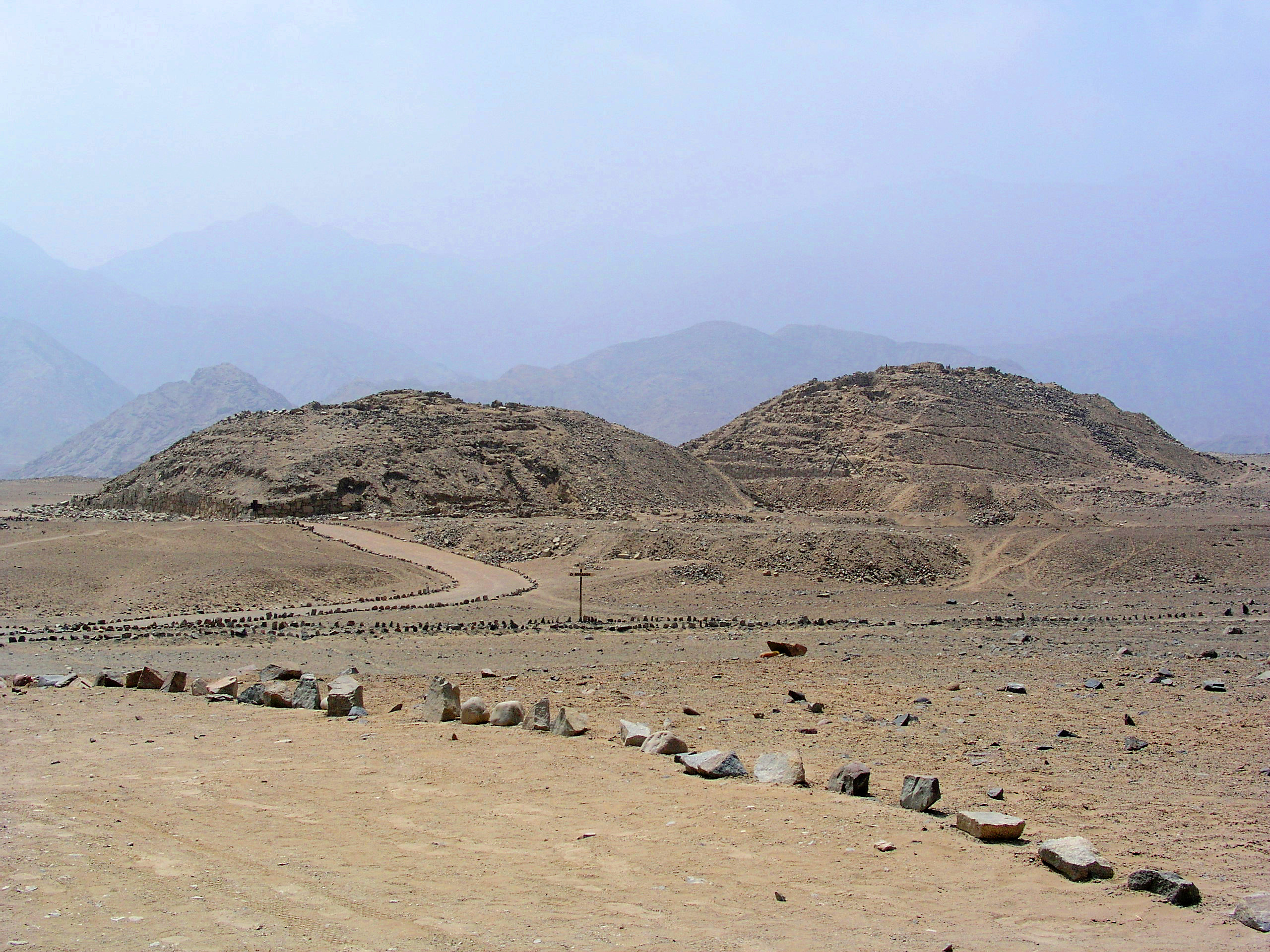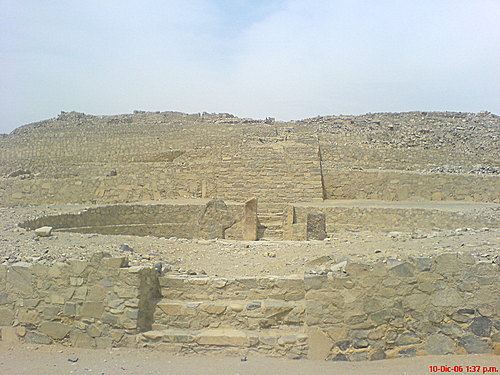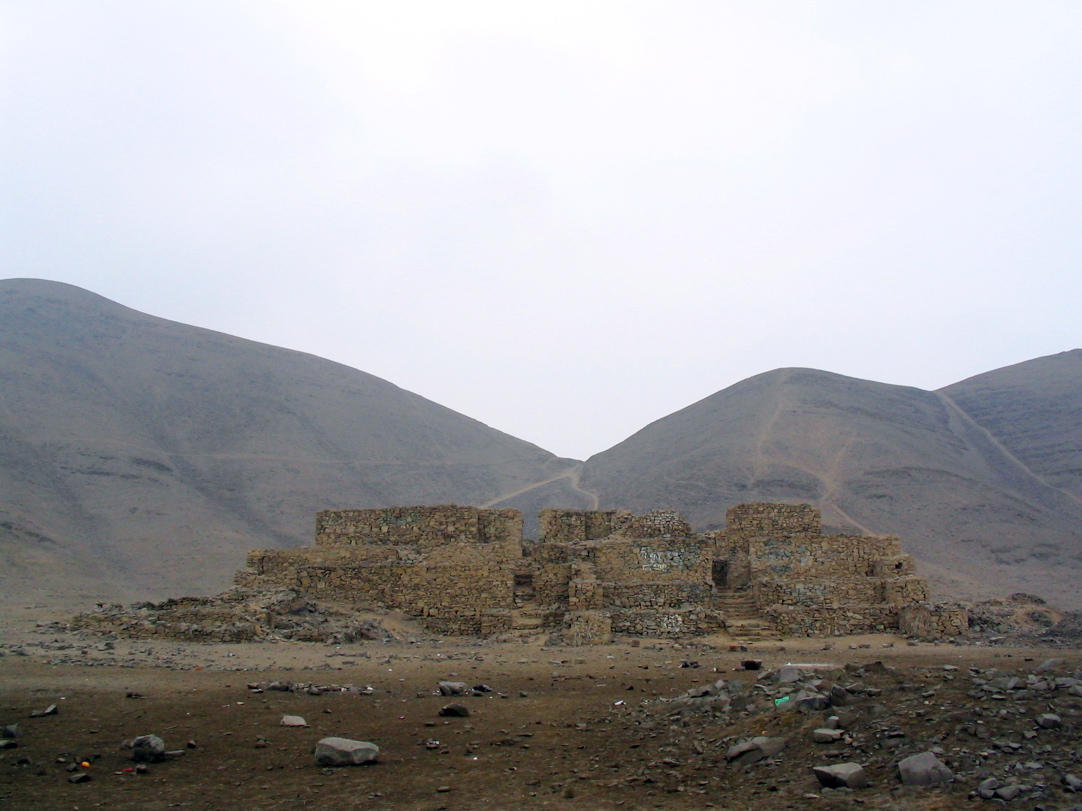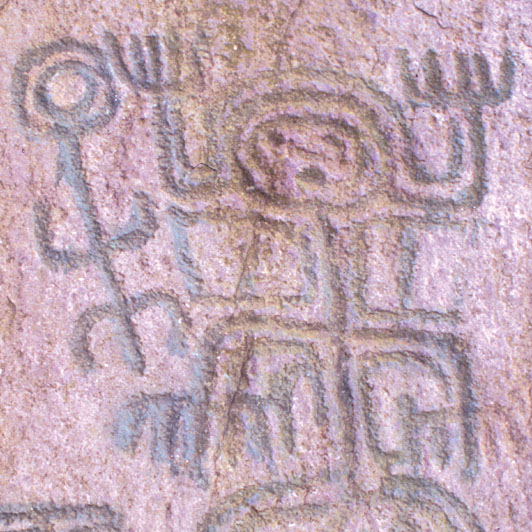Andean preceramic on:
[Wikipedia]
[Google]
[Amazon]
 The Andean preceramic refers to the early period of human occupation in the
The Andean preceramic refers to the early period of human occupation in the
 Caral/Norte Chico is one of the most notable and well-studied cultures in Peruvian archaeology. The most impressive achievement of this civilization was its monumental architecture, including large earthwork
Caral/Norte Chico is one of the most notable and well-studied cultures in Peruvian archaeology. The most impressive achievement of this civilization was its monumental architecture, including large earthwork

 Sophisticated government is assumed to have been required to manage the ancient Caral/Norte Chico. Questions still remain over its organization, particularly the influence of food resources on politics.
Some scholars suggested that Norte Chico was founded on seafood and maritime resources, rather than on the development of an agricultural cereal and crop surpluses, as has been considered essential to the rise of other ancient civilizations. Yet now these views are being revised because of strong evidence for maize consumption.
Sophisticated government is assumed to have been required to manage the ancient Caral/Norte Chico. Questions still remain over its organization, particularly the influence of food resources on politics.
Some scholars suggested that Norte Chico was founded on seafood and maritime resources, rather than on the development of an agricultural cereal and crop surpluses, as has been considered essential to the rise of other ancient civilizations. Yet now these views are being revised because of strong evidence for maize consumption.
 El Paraiso, Peru is a very large early center in the Ancón-Chillón Valley, that may be somewhat related to the Norte Chico tradition. It is approximately from the same time frame as the above. It is just one of the six major preceramic sites in the Ancón-Chillón Valley, including
El Paraiso, Peru is a very large early center in the Ancón-Chillón Valley, that may be somewhat related to the Norte Chico tradition. It is approximately from the same time frame as the above. It is just one of the six major preceramic sites in the Ancón-Chillón Valley, including
 El Abra is an important early human settlement site in Colombia with a large cave system. Its investigation started in 1967, and the stratigraphy of lithic instruments, bones and vegetal
El Abra is an important early human settlement site in Colombia with a large cave system. Its investigation started in 1967, and the stratigraphy of lithic instruments, bones and vegetal
 The Andean preceramic refers to the early period of human occupation in the
The Andean preceramic refers to the early period of human occupation in the Andean
The Andes, Andes Mountains or Andean Mountains (; ) are the longest continental mountain range in the world, forming a continuous highland along the western edge of South America. The range is long, wide (widest between 18°S – 20°S ...
area of South America that preceded the introduction of ceramics. This period is also called pre-ceramic or aceramic Aceramic is defined as "not producing pottery". In archaeology, the term means "without pottery".
Aceramic societies usually used bark, basketry, gourds and leather for containers. It is sometimes used to refer to a specific early Neolithic period ...
.
Earliest human occupations
The earliest humans that came to South America are known as Paleo-Indians. This period is generally known as theLithic stage
In the sequence of cultural stages first proposed for the archaeology of the Americas by Gordon Willey and Philip Phillips in 1958, the Lithic stage was the earliest period of human occupation in the Americas, as post-glacial hunter gatherers s ...
. After this came the period that is widely known as Archaic, although there are also some different classifications of this period. The precise classification is complicated because somewhat different terminologies tend to be used for North America
North America is a continent in the Northern Hemisphere and almost entirely within the Western Hemisphere. It is bordered to the north by the Arctic Ocean, to the east by the Atlantic Ocean, to the southeast by South America and the C ...
and Mesoamerica
Mesoamerica is a historical region and cultural area in southern North America and most of Central America. It extends from approximately central Mexico through Belize, Guatemala, El Salvador, Honduras, Nicaragua, and northern Costa Rica. With ...
.
The Andean preceramic period would include cultures that belong to Lithic and Archaic stages.
Preceramic in Peru
TheZaña Valley
Zaña (also Saña) is the capital of Zaña District in the Chiclayo Province of Lambayeque region in northern Peru. It is located inland from the Pacific Ocean at an elevation of in the valley of the Zaña River. Zaña had a population of 4,51 ...
in northern Peru contains the earliest known canals in South America. These were small stone-lined canals which drew water from streams in the Andes Mountains region. These canals may have been built as early as 4700 BC.
A great deal of archaeological work has been done in Peru in relation to the preceramic cultures, and while Caral/Norte Chico civilization has now been studied extensively, there are also many other sites being studied.
Caral/Norte Chico civilization
 Caral/Norte Chico is one of the most notable and well-studied cultures in Peruvian archaeology. The most impressive achievement of this civilization was its monumental architecture, including large earthwork
Caral/Norte Chico is one of the most notable and well-studied cultures in Peruvian archaeology. The most impressive achievement of this civilization was its monumental architecture, including large earthwork platform mound
Platform may refer to:
Technology
* Computing platform, a framework on which applications may be run
* Platform game, a genre of video games
* Car platform, a set of components shared by several vehicle models
* Weapons platform, a system o ...
s and sunken circular plaza
A town square (or square, plaza, public square, city square, urban square, or ''piazza'') is an open public space, commonly found in the heart of a traditional town but not necessarily a true geometric square, used for community gatherings. ...
s. Also, these preceramic peoples built massive irrigation and water management projects.
Archaeological evidence suggests a very early use of textile
Textile is an umbrella term that includes various fiber-based materials, including fibers, yarns, filaments, threads, different fabric types, etc. At first, the word "textiles" only referred to woven fabrics. However, weaving is not the ...
s, and in particular the use of cotton. Also, recent studies (2013) indicate that maize
Maize ( ; ''Zea mays'' subsp. ''mays'', from es, maíz after tnq, mahiz), also known as corn (North American and Australian English), is a cereal grain first domesticated by indigenous peoples in southern Mexico about 10,000 years ago. The ...
played a significant role in this civilization starting as early as 3000 BC, contrary to previous findings. Beans and sweet potato were grown as well.
Caral/Norte Chico sites are notable for exceptional collective density, as well as individual size. Haas argues that the density of sites in such a small area is globally unique for a nascent civilization. During the third millennium BC, Caral/Norte Chico may have been the most densely populated area of the world (excepting, possibly, northern China). The Supe, Pativilca, Fortaleza, and Huaura River valleys each have several related sites.
Caral

Caral
The Sacred City of Caral-Supe or simply Caral, is an archaeological site where the remains of the main city of the Caral civilization are found. It is located in Peru in the Supe valley, near the current town of Caral, 182 kilometers north of ...
is an important center of this civilization. The city was inhabited between 2600 and 2000 BCE, enclosing an area of more than 60 hectares.
Caral was first fully documented and analyzed by Dr. Ruth Shady Solís and other Peruvian archaeologists in the late 1990s. A 2001 paper in ''Science
Science is a systematic endeavor that builds and organizes knowledge in the form of testable explanations and predictions about the universe.
Science may be as old as the human species, and some of the earliest archeological evidence for ...
'', providing a survey of the Caral research, and a 2004 article in ''Nature
Nature, in the broadest sense, is the physical world or universe. "Nature" can refer to the phenomena of the physical world, and also to life in general. The study of nature is a large, if not the only, part of science. Although humans are p ...
'', describing fieldwork and radiocarbon dating
Radiocarbon dating (also referred to as carbon dating or carbon-14 dating) is a method for determining the age of an object containing organic material by using the properties of radiocarbon, a radioactive isotope of carbon.
The method was dev ...
across a wider area, revealed Norte Chico's full significance and led to widespread interest.
As a result, Caral/Norte Chico has pushed back the horizon for complex societies in the Peruvian region by more than one thousand years.
Huaricanga
Huaricanga
Huaricanga is the earliest city of the Norte Chico civilization, called Caral or Caral-Supe in Peru and Spanish language sources. "It existed around 3500 BC and was the oldest city in the Americas and one of the earliest cities in the world." This ...
, also in the Norte Chico region, is believed to be the earliest city of this civilization, and thus it would have been the oldest city in the Americas. It existed around 3500 BCE."
Besides the lack of pottery, a remarkable feature of this civilization is the apparent absence of any artistic or religious symbolism. Or at least they have not been identified so far.
Nevertheless, there is evidence for the worship of certain deities, such as the Staff God
In Andean Iconography front-facing figures are often referred to as Staff Gods and thought to represent deities in Andean cultures. There is no uniform representation of a "Staff God". Dozens of variations of "Staff Gods" exist. Usually a Staff G ...
, a leering figure with a hood and fangs. The Staff God is a major deity of later Andean cultures, and it has been suggested that its use so early points to the worship of common symbols of gods for a long period of time.
 Sophisticated government is assumed to have been required to manage the ancient Caral/Norte Chico. Questions still remain over its organization, particularly the influence of food resources on politics.
Some scholars suggested that Norte Chico was founded on seafood and maritime resources, rather than on the development of an agricultural cereal and crop surpluses, as has been considered essential to the rise of other ancient civilizations. Yet now these views are being revised because of strong evidence for maize consumption.
Sophisticated government is assumed to have been required to manage the ancient Caral/Norte Chico. Questions still remain over its organization, particularly the influence of food resources on politics.
Some scholars suggested that Norte Chico was founded on seafood and maritime resources, rather than on the development of an agricultural cereal and crop surpluses, as has been considered essential to the rise of other ancient civilizations. Yet now these views are being revised because of strong evidence for maize consumption.
Casma and Sechin rivers
Several major preceramic archaeological sites are located in the valleys of theCasma River
The Casma River, which upstream is called Río Grande, is a river that crosses northern Casma province in the Ancash Region of Peru. It originates in the Black Mountain Range and drains into the Pacific Ocean. Major tributaries include the Sech ...
and its tributary the Sechin River Sechin may refer to:
* Sechin (surname)
* Séchin, a commune in France
* Cerro Sechin, an archaeological site in Peru
* Sechin Alto, an archaeological site in Peru
* Sechin Bajo
Sechin Bajo is a large archaeological site with ruins dating fro ...
. The largest among them is Sechin Alto
Sechin Alto is a massive architectural complex in Peru belonging to the Early Formative period (2000-1500 BC). It is located in the Casma Province, the Ancash Region, on the left bank of the Sechín River, east of the town of the same name. Ot ...
; the other big mounds are Sechin Bajo
Sechin Bajo is a large archaeological site with ruins dating from 3500 BCE to 1300 BCE, making it not only one of the oldest centers of civilization in the Western Hemisphere, but also one of the oldest civilization centers on earth. Sechin Baj ...
, Mojeque
Mojeque, or ''Pampa de las Llamas-Moxeke'', is a large archaeological site located in the Casma Province of Ancash Region in northern Peru. Archaeologists believe it functioned as a temple or religious structure. It contains two large mounds, m ...
, Cerro Sechin, Las Haldas
Las Haldas or Las Aldas is a large archaeological complex from before and during the initial ceramic period (1800–1000 BCE) of Peru. Las Haldas is located on the Pacific coast approximately north of Lima and about south of the Casma rive ...
and several others. The dates for these sites start at c. 3600 BCE.
Kotosh Religious Tradition
The Kotosh Religious Tradition is a term used byarchaeologists
Archaeology or archeology is the scientific study of human activity through the recovery and analysis of material culture. The archaeological record consists of artifacts, architecture, biofacts or ecofacts, sites, and cultural landscapes ...
to refer to the ritual buildings that were constructed in the mountain drainages of the Andes between circa 3000 and c.1800 BCE, during the Andean preceramic. /sup>
Archaeologists have identified and excavated a number of these ritual centers; the first of these to be discovered was that at Kotosh
Kotosh is an archaeological site near the town of Huánuco, Peru, consisting of a series of buildings comprising six periods of continuous occupation.
Stratigraphy
Three cultural phases which preceded the Chavin culture were identified at Kotosh ...
, although since then further examples have been found at Shillacoto, Wairajirca, Huaricoto, La Galgada and Piruru. /sup> These sites are all located in highland zones that are lower than the Puna, and yet there are considerable distances separating them. In spite of this, all these cases of highland preceramic public architecture are remarkably similar. /sup>
Other cultural traditions
 El Paraiso, Peru is a very large early center in the Ancón-Chillón Valley, that may be somewhat related to the Norte Chico tradition. It is approximately from the same time frame as the above. It is just one of the six major preceramic sites in the Ancón-Chillón Valley, including
El Paraiso, Peru is a very large early center in the Ancón-Chillón Valley, that may be somewhat related to the Norte Chico tradition. It is approximately from the same time frame as the above. It is just one of the six major preceramic sites in the Ancón-Chillón Valley, including Ancon (archaeological site)
Ancon (archaeological site) is located in the north of the Bay of Ancon, in the Ancón District, on the central coast of Peru. It is one of the most important centers of the Peruvian archeology and features a vast necropolis of the pre-Hispanic ...
.
Another important site is Bandurria, Peru, on the Huaura River, featuring monumental architecture that may go back to mid-fourth millennium BC.
In the northern peruvian coast stand out sites such as Huaca Prieta
Huaca Prieta is the site of a prehistoric settlement beside the Pacific Ocean in the Chicama Valley, just north of Trujillo, La Libertad Province, Peru. It is a part of the El Brujo Archaeological Complex, which also includes Moche (culture) s ...
, were the earliest recorded use of indigo dye to date was found and Huaca Ventarron, its painted murals are the oldest discovered in the Americas.
Preceramic in Ecuador
In Ecuador, the Preceramic period is believed to have started around 9000 BC, and lasted until around 4200 BC. According to Jeffrey Quilter, Ecuador yielded plentiful evidence of early dense occupations of the highlands that is so far not found either in Peru or in Bolivia. Along the Pacific Coast, theLas Vegas
Las Vegas (; Spanish for "The Meadows"), often known simply as Vegas, is the 25th-most populous city in the United States, the most populous city in the state of Nevada, and the county seat of Clark County. The city anchors the Las Vega ...
culture predominated, while up in the mountains, it was the Inga culture.
The Las Vegas culture is the first known culture in Ecuador. They lived on the Santa Elena Peninsula The Santa Elena Peninsula is a peninsula in Santa Elena Province, Ecuador. The Santa Elena Peninsula contains the westernmost point on mainland Ecuador and is bordered by the Gulf of Guayaquil to the south and the Santa Elena Bay to the north.
Th ...
on the coast of Ecuador between 9000–6000 BC. The skeletal remains and other finds preserve much evidence of this culture.
Scientists have classified three phases of cultural development. The earliest people were hunter-gathers and fisherman. Approximately 6000 BC, these peoples were among the first to begin farming; among their early crops were bottle gourd, ''Lagenaria siceraria
Calabash (; ''Lagenaria siceraria''), also known as bottle gourd, white-flowered gourd, long melon, birdhouse gourd, New Guinea bean, Tasmania bean, and opo squash, is a vine grown for its fruit. It can be either harvested young to be consumed ...
'', and an early type of maize
Maize ( ; ''Zea mays'' subsp. ''mays'', from es, maíz after tnq, mahiz), also known as corn (North American and Australian English), is a cereal grain first domesticated by indigenous peoples in southern Mexico about 10,000 years ago. The ...
, ''Zea mays
Maize ( ; ''Zea mays'' subsp. ''mays'', from es, maíz after tnq, mahiz), also known as corn (North American and Australian English), is a cereal grain first domesticated by indigenous peoples in southern Mexico about 10,000 years ago. The ...
'' L.
El Inga peoples lived high in the mountains near present-day Quito, the capital of Ecuador. Evidence from the archeological site El Inca date the culture to 9000–8000 BC. Excavations were undertaken around 1961. It is believed that, from the archaeological perspective, this area is one of the most important in South America, and it may have existed along an ancient trade route.
Some of the tools used by these early nomadic hunters have provided relationships to the Clovis culture
The Clovis culture is a prehistoric Paleo-Indians, Paleoamerican culture, named for distinct stone and bone tools found in close association with Pleistocene fauna, particularly two mammoths, at Blackwater Locality No. 1 near Clovis, New Mexic ...
"Level I" at Fell's Cave in southern Chile, and technological relationships to the late Pleistocene "fluted point" complexes of North America.
Preceramic in Colombia
 El Abra is an important early human settlement site in Colombia with a large cave system. Its investigation started in 1967, and the stratigraphy of lithic instruments, bones and vegetal
El Abra is an important early human settlement site in Colombia with a large cave system. Its investigation started in 1967, and the stratigraphy of lithic instruments, bones and vegetal charcoal
Charcoal is a lightweight black carbon residue produced by strongly heating wood (or other animal and plant materials) in minimal oxygen to remove all water and volatile constituents. In the traditional version of this pyrolysis process, cal ...
with radiocarbon dating
Radiocarbon dating (also referred to as carbon dating or carbon-14 dating) is a method for determining the age of an object containing organic material by using the properties of radiocarbon, a radioactive isotope of carbon.
The method was dev ...
established the date of the settlement in 12,400 BP ± 160 years. Other preceramic archaeological sites are Tibitó
Tibitó is the second-oldest dated archaeological site on the Altiplano Cundiboyacense, Colombia.Tequendama
Tequendama is a preceramic and ceramic archaeological site located southeast of Soacha, Cundinamarca, Colombia, a couple of kilometers east of Tequendama Falls. It consists of multiple evidences of late Pleistocene to middle Holocene populati ...
, dated to 11,000 years BP, Checua
Checua is a preceramic open area archaeological site in Nemocón, Cundinamarca, Colombia. The site is located north of the town centre.Gómez Mejía, 2012, p.146 At Checua, thousands of stone and bone tools, stone flakes and human remains have ...
(dated to 8500 BP), Aguazuque
Aguazuque is a pre-Columbian archaeological site located in the western part of the municipality Soacha, close to the municipalities Mosquera and San Antonio del Tequendama in Cundinamarca, Colombia. It exists of evidences of human settlement o ...
(5000 BP) and '' El Infiernito'', dated to 4900 years BP.
Preceramic in Bolivia
The earliest cultures of Bolivia are the Wankarani culture, and the Chiripa. The earliest Wankarani sites are dated from 1800 BC onwards. Wankarani culture arose in the area of the currentOruro Department
Oruro (; Quechua: ''Uru Uru''; Aymara: ''Ururu'') is a department of Bolivia, with an area of . Its capital is the city of Oruro. According to the 2012 census, the Oruro department had a population of 494,178.
Provinces of Oruro
The depar ...
in Bolivia near Lake Poopo. The Wankarani had developed a copper metallurgy by 1200 B.C.
The area of the Altiplano
The Altiplano (Spanish for "high plain"), Collao (Quechua and Aymara: Qullaw, meaning "place of the Qulla") or Andean Plateau, in west-central South America, is the most extensive high plateau on Earth outside Tibet. The plateau is located at t ...
close to Bolivia yielded the earliest evidence of metalworking in South America. This is the site of Jisk'a Iru Muqu, also spelled Jiskairumoko, in the Lake Titikaka basin, which was first investigated in 1994. A necklace consisting of nine gold beads was found in an excavated grave located next to a Terminal Archaic pit-house
A pit-house (or ''pit house'', ''pithouse'') is a house built in the ground and used for shelter. Besides providing shelter from the most extreme of weather conditions, these structures may also be used to store food (just like a pantry, a larde ...
. Charcoal recovered from the burial dates the gold beads to 2155-1936 cal BC
Preceramic in Chile
Some of the early preceramic cultures flourished both in Peru and in Chile. This applies to the Chinchorro culture that was active in what is now northern Chile and southern Peru. This culture left us the Chinchorro mummies; these are the oldest examples of artificially mummified human remains in the world. The oldest mummy recovered from theAtacama Desert
The Atacama Desert ( es, Desierto de Atacama) is a desert plateau in South America covering a 1,600 km (990 mi) strip of land on the Pacific coast, west of the Andes Mountains. The Atacama Desert is the driest nonpolar desert in the w ...
is dated around 7020 BC.Arriaza, Bernardo T. Beyond Death: The Chinchorro Mummies of Ancient Chile. Washington: Smithsonian Institution, 1995. Print. This tradition is believed to have reached a peak around 3000 BC.
See also
* History of Andean South America *Cultural periods of Peru
This is a chart of cultural periods of Peru and the Andean Region developed by John Rowe and Edward Lanning and used by some archaeologists studying the area. An alternative dating system was developed by Luis Lumbreras and provides different dat ...
* Inhabitation of the Altiplano Cundiboyacense
References
Bibliography
* * * * * * * * *External links
* *{{cite LSA , last=Higueras , first=Álvaro , year=s.a , title=The Preceramic Period , url=http://www.tiwanakuarcheo.net/10_prehistory/GUIAPreceramic.htm , accessdate=2016-07-08 Science and technology in South America Archaic period in the Americas 1